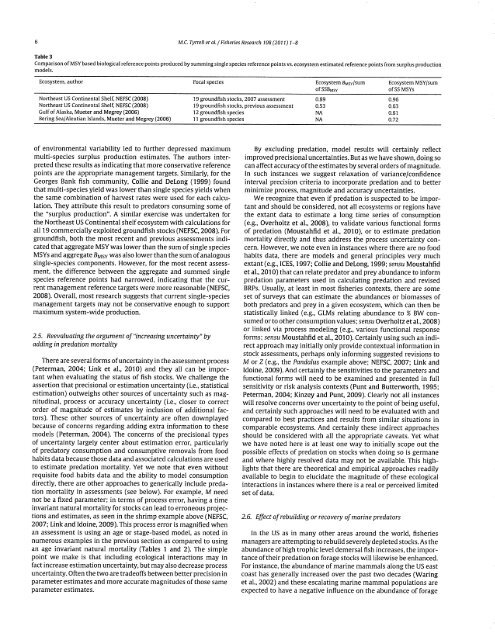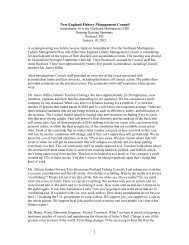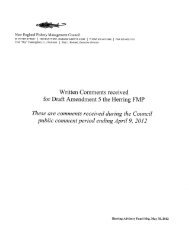Correspondence/Amendment 5 Comments - New England Fishery ...
Correspondence/Amendment 5 Comments - New England Fishery ...
Correspondence/Amendment 5 Comments - New England Fishery ...
Create successful ePaper yourself
Turn your PDF publications into a flip-book with our unique Google optimized e-Paper software.
M.C. Tyneq et al. / Fisheries Research 1 08 (201 1 ) 1 -8<br />
Table 3<br />
Comparison ofMSY based biological reference points produced by summing single species reference points vs. ecosystem estimated reference points from surplus production<br />
models.<br />
Ecosystem, author Focal species Ecosystem Bs5y/sum<br />
Ecosystem MSY/sum<br />
ofSSBy5y<br />
ofSS MSYS<br />
Norrheasr US Continenral Shell NEFSC (2008)<br />
Northeast us continental shelf, NEFsc (2008)<br />
Gulf ofAlaska, Mueter and Megrey (2006)<br />
Bering Sea/Aleutiãn lslands, Mueter and Megrey (2006)<br />
of environmental variability led to further depressed maximum<br />
multi-species surplus production estimates. The authors interpreted<br />
these results as indicating that more conservative reference<br />
points are the appropriate management targets. Similarly, for the<br />
Georges Bank fish community, Collie and Delong (1999) found<br />
that multi-species yield was lower than single species yields when<br />
the same combination of harvest rates were used for each calculation.<br />
They attribute this result to predators consuming some of<br />
the "surplus production". A similar exercise was undertaken for<br />
the Northeast US Continental shelf ecosystem with calculations for<br />
all 19 commercially exploited groundfish srocks (NEFSC, 2008). For<br />
groundfish, both the most recent and previous assessments indi<br />
cated that aggregate MSY was lower than the sum of single species<br />
MSYs and aggregateBMsy was also lowerthan the sum of analogous<br />
single-species components. However, for the most recent assessment,<br />
the difference between the aggregate and summed single<br />
species reference points had narrowed, indicating that the current<br />
management reference targets were more reasonable (NEFSC,<br />
2008). Overall, most research suggests that current single-species<br />
management targets may not be conservative enough to support<br />
maximum system-wide production.<br />
2.5. Reevaluatíng the argumeft of "increasing uncertainty" by<br />
adding in predation mortality<br />
There are several forms ofuncertaintyin the assessmentprocess<br />
(Peterman, 2004; Link et al., 2010) and they all can be important<br />
when evaluating the status of fish stocks. We challenge the<br />
assertion that precisional or estimation uncertainty (i.e., statistical<br />
estimation) outweighs other sources of uncertainty such as magnitudinal,<br />
process or accuracy uncertainty (i.e., closer to correct<br />
order of magnitude of estimates by inclusion of additional factors).<br />
These other sources of uncertainty are often downplayed<br />
because of concerns regarding adding extra information to these<br />
models (Peterman, 2004). The concerns of the precisional types<br />
of uncertainty largely center about estimation error, particularly<br />
of predatory consumption and consumptive removals from food<br />
habits data because those data and associated calculations are used<br />
to estimate predation mortality. Yet we note that even without<br />
requisite food habits data and the ability to model consumption<br />
directly, there are other approaches to generically include predation<br />
mortalit5l in assessments (see below). For example, M need<br />
not be a fixed parameter; in terms of process error, having a time<br />
invariant natural mortality for stocks can lead to erroneous projections<br />
and estimates, as seen in the shrimp example above (NEFSC,<br />
2007; Link and ldoine, 2009). This process error is magnified when<br />
an assessment is using an age or stage-based model, as noted in<br />
numerous examples in the previous section as compared to using<br />
an age invariant natural mortality (Tables 1 and 2). The simple<br />
point we make is that including ecological interactions may in<br />
fact increase estimation uncertainty, but may also decrease process<br />
uncertainty. Often the two are tradeoffs between better precision in<br />
parameter estimates and more accurate magnitudes of those same<br />
parameter estimates.<br />
19 groundfish stocks, 2007 assessment<br />
19 groundfish stocks, previous assessment<br />
12 groundfish species<br />
1 1 groundfish species<br />
0.89<br />
0.s3<br />
NA<br />
NA<br />
0.96<br />
0.63<br />
0.61<br />
0.72<br />
By excluding predation, model results will certainly reflect<br />
improved precisional uncertainties. But as we have shown, doing so<br />
can affect accuracy ofthe estimates by several orders ofmagnitude.<br />
ln such instances we suggest relaxation of variance/confidence<br />
interval precision criteria to incorporate predation and to better<br />
minimize process, magnih¡de and accuracy uncertainties.<br />
We recognize that even if predation is suspected to be important<br />
and should be considered, not all ecosystems or regions have<br />
the extant data to estimate a long time series of consumption<br />
(e.g., Overholtz et al., 2008), to validate various functional forms<br />
of predation (Moustahfid et al., 2010), or to estimate predation<br />
mortality directly and thus address the process uncertainty concern.<br />
However, we note even in instances where there are no food<br />
habits data, there are models and general principles very much<br />
extant (e.g., ICES, 1997; Collie and Delong, 1999; sensu Moustahfid<br />
et al., 2010) that can relate predator and prey abundance to inform<br />
predation parameters used in calculating predation and revised<br />
BRPs. Usually, at least in most fisheries contexts, there are some<br />
set of surveys that can estimate the abundances or biomasses of<br />
both predators and prey in a given ecosystem, which can then be<br />
statistically linked (e.g., GLMs relating abundance to % BW consumed<br />
orto other consumption values;sensu Overholtz etal.,2008)<br />
or linked via process modeling (e.g., various functional response<br />
forms; sensu Moustahfid et al., 2010). Certainly using such an indirect<br />
approach may initially only provide contextual information in<br />
stock assessments, perhaps only informing suggested revisions to<br />
M or Z (e.g., the Pandalus example above; NEFSC, 2007; Link and<br />
ldoine,2009). And certainly the sensitivities to the parameters and<br />
functional forms will need to be examined and presented in full<br />
sensitivity or risk analysis contexts (Punt and Butterworth, 1995;<br />
Peterman, 2004; Kinzey and Punt, 2009). Clearly not all instances<br />
will resolve concerns over uncertainty to the point ofbeing useful,<br />
and certainly such approaches will need to be evaluated with and<br />
compared to best practices and results from similar situations in<br />
comparable ecosystems. And certainly these indirect approaches<br />
should be considered with all the appropriate caveats. Yet what<br />
we have noted here is at least one way to initially scope out the<br />
possible effects of predation on stocks when doing so is germane<br />
and where highly resolved data may not be available. This highlights<br />
that there are theoretical and empirical approaches readily<br />
available to begin to elucidate the magnitude of these ecological<br />
interactions in instances where there is a real or perceived limited<br />
set of data.<br />
2.6. Effect of rebuililing or recovery of maríne predators<br />
In the US as in many other areas around the world, fisheries<br />
managers are attempting to rebuild severely depleted stocks. As the<br />
abundance ofhigh trophic level demersal fish increases, the importance<br />
oftheir predation on forage stocks will likewise be enhanced.<br />
For instance, the abundance of marine mammals along the US east<br />
coast has generally increased over the past two decades (Waring<br />
et al., 2002) and these escalating marine mammal populations are<br />
expected to have a negative influence on the abundance of forage







